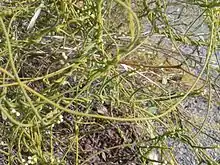Cuscuta reflexa
Cuscuta reflexa, the giant dodder,[1] is one of 100-170 species in the genus Cuscuta.
| Cuscuta reflexa | |
|---|---|
 | |
| Scientific classification | |
| Kingdom: | Plantae |
| Clade: | Tracheophytes |
| Clade: | Angiosperms |
| Clade: | Eudicots |
| Clade: | Asterids |
| Order: | Solanales |
| Family: | Convolvulaceae |
| Genus: | Cuscuta |
| Species: | C. reflexa |
| Binomial name | |
| Cuscuta reflexa Roxb. | |
This plant species is common in the Indian Subcontinent and the Greater Himalayas.[2] This parasitic plant species is a leafless twined sprawling thin vine that grows over a host plant. This species capable of producing numerous branches which can cover the host plant within a very short period of time and suck life out of the host plant. Flowers are small, bell shaped and white in colour with yellow filaments. Fruits and seeds are produced from the flower. This species is used in producing traditional medicines for the treatment of headache, labour pain, bone fracture, fever, rheumatism etc.[2]
Gallery
 Cuscuta reflexa grows on other plants.
Cuscuta reflexa grows on other plants. Cuscuta reflexa flowers
Cuscuta reflexa flowers
References
- "Cuscuta reflexa". Natural Resources Conservation Service PLANTS Database. USDA. Retrieved 19 December 2015.
- O'Neill, A.R.; Rana, S.K. (2019). "An ethnobotanical analysis of parasitic plants (Parijibi) in the Nepal Himalaya". Journal of Ethnobiology and Ethnomedicine. 12 (14). doi:10.1186/s13002-016-0086-y. PMID 26912113.
This article is issued from Wikipedia. The text is licensed under Creative Commons - Attribution - Sharealike. Additional terms may apply for the media files.